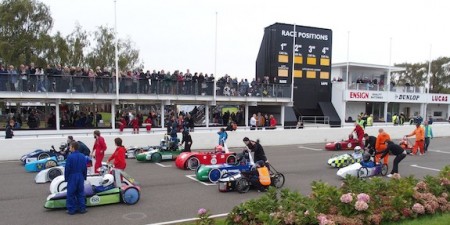Electric cars with limited range are at the core of the work of the Greenpower Educational Trust.
Aimed at inspiring future generations of engineers, Greenpower organises a series of races for schools and colleges and apprentices. The teams must build and race their own electric powered racing cars from a kit of parts supplied by Greenpower, ensuring that the cars are as near identical as possible where the electrical and mechanical components are concerned.
The race series are arranged into “Formulas”, according to the age of their drivers and this year, the Trust teamed up with the FIA to stage five support races around the world for the new Formula E series, racing as the Formula E Schools Series. So far the Formula E rounds in Argentina, the USA, UK and Germany have announced School Series races.
For most Greenpower series participants, it all starts with a kit, built at school. Having built the cars, there are a series of regional heats, including one at the Western Group’s home circuit Castle Combe, followed by an international final to determine the winners in each Formula. The races are not about speed, but endurance.
Teams are split into three race formulas, depending on the age of the participating teams. The entry level is the IET Formula Goblin series designed for children between 9 and 11. Car kits are supplied flat packed and schools can seek sponsorship from local businesses.
Teams are free to design their own bodywork and can take part in as many of the heats around the country as they wish. These tiny cars are capable of speeds up to around 15mph, driven by the children themselves.
Racing is a small part of the event for the Goblins, who compete in slalom, sprint and drag races for the final, staged at Goodwood.

Those between 11 and 16 participate in the IET Formula 24 races, open to schools, youth organisations and privateers. These cars are larger and faster than the Goblin series cars, capable of speeds up to around 25 mph. For the Formula 24 series, the focus is on building and racing the cars with heats staged at racing circuits around the country, including Castle Combe.
Each heat consists of two 90 minute races with teams using identical motors and limited to two identically rated 12-volt batteries per race. Between the races, where teams have entered for the Formula 24+ Series, heats take place for these cars.
Formula 24+ is aimed at 16-25 year olds. Again, the cars use a standard motor and batteries and must take part in at least three of eight national events to qualify for the final, shared with the Formula 24 cars.
The variety of designs for the F24 and F24+ cars is impressive, from one 2014 entry called Brian, for those who remember the Magic Roundabout, designed to look like a snail, to F1 inspired cars. Gearing and aerodynamics appear to be the key to success.
Speed matters in that the cars have to cover a certain distance in the races to qualify for the finals, but the batteries cannot be changed or re-charged during the races and there are inevitably those that run out of power before the chequered flag.
The skill and ingenuity of the teams is what shines through – designing bodywork to improve aerodynamics and calculating tyre pressures to reduce rolling resistance while maintaining acceptable handling. The local Goblin Formula race is held at Renishaw’s Wotton-Under-Edge global headquarters and the Gloucestershire based engineering company has become a major Greenpower sponsor, with apprentices also competing in the F24+ series.
For 2015, the final will move from Goodwood to Rockingham and will become a two day event on 10-11 October.

This follows on from the first international final at Goodwood in October 2014, with competing teams travelling from the USA and South Africa to take part.
The date for the Castle Combe round has yet to be announced – watch this space.

